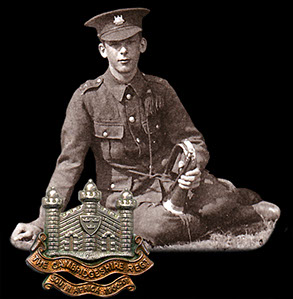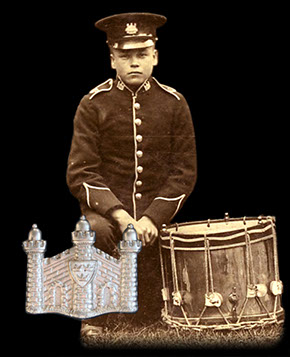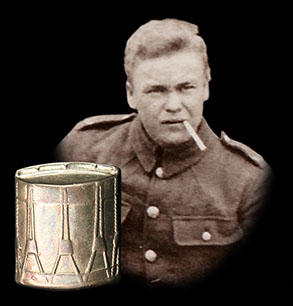
Who Were
The Cambs
The Cambs
at War
1/1st Btn 1914-1919
1914 - 1/1st Overview
1915 - 1/1st Overview
1915 - St Eloi
1915 - Fosse Wood
1916 - 1/1st Overview
1916 - The Schwaben
1916 - St Pierre Divion
1917 - 1/1st Overview
1917 - St Julien
Insignia, Medals & Books
Remembering The Cambs
Biographies
About Us &
This Site
Underage Soldiers in the Cambridgeshires
When war was declared on August 4, 1914, it produced a patriotic surge of enlistment by men eager to do their bit for King and Country. With many suggesting it would be all over by Christmas, the recruiting offices throughout the country were sometimes overwhelmed by would-be soldiers.
As a result of the volume of men, it might explain why large numbers of boys managed to trick their way into uniform. A report in January 1915 stated that 5,534 men from Cambridgeshire and the Isle of Ely had joined up. Some of them joined the Cambridgeshire Regiment, filling the 1/1st Battalion and then its Reserve Battalion (soon known as 2/1st Btn) by October 31, 1914. Local noticeboards proudly displayed rolls of honour listing the names of those who had agreed to fight.
With some regiments soon taking males of a minimum 5ft 3in instead of the normal 5ft 6in tall, even boys of shorter stature could slip through the net.
As many Territorial Force units trained hard ready to be sent overseas, the Army Council issued an instruction in December 1914 reiterating that no member of the Territorial Force under 19 years of age was to be allowed to join the Expeditionary Force. Complaints were being voiced that untrained and immature teenagers had been allowed to proceed overseas with some Territorial units, in spite of earlier orders that no one in a TF unit should proceed to overseas unless medically fit, fully trained and 19 years of age or over.
One reason this happened was that Territorial Force regulations allowed ‘Special Enlistments’ where boys between 14 and 17 years of age, with the consent of their parents or guardians, could join as bandsmen. This had certainly happened before the war in all of the eight pre-war companies of the Cambridgeshire Regiment, and these young drummers and buglers are easy to pick out in photographs.
The standard minimum age of enlistment in the TF was set at 17, although all those below the age of 19 were not eligible to volunteer for overseas service. Many of those that had joined the Cambridgeshire Regiment before the War, particularly in the recruitment drive of January 1914 were 17 or 18. These boys could not volunteer for Imperial Service, but it didn’t stop some getting to the front line by later adjusting their ages. When the 1/1st Btn went to the Western Front on February 14, 1915, it is certain some of those serving in its ranks were under 19. However, other pre-war ‘boy’ bandsmen and recruits under 19 had been prevented from volunteering for overseas service and remained at home in the 2/1st Btn.
Once the 1/1st Btn had sailed to the Western Front, the War Office gave authority for the Cambridgeshire Regiment to form a second reserve battalion, which would become known as the 3/1st Btn, but recruits had to be 19 years old. Of course, after the National Registration scheme in 1915, the Derby Scheme and then, in 1916, conscription, all men were placed into age groups, which would be called up when required.
The Army’s continued concern about Territorial Force soldiers being at the front while under the age for active service had prompted another instruction in June 1915. This stated that any immature solider of the TF at the front would be returned to the UK, with those under 18 sent to their regiment’s home service unit, those between 18 and 18½ posted to the second line unit, and those above 18½ to the third line unit. The minimum age for overseas service remained at 19 until the spring of 1918, when it was lowered to 18 and 6 months providing the soldier had had a minimum of 6 months training.
There are cases of young soldiers serving overseas in the 1/1st Cambridgeshires from February 1915. One such example is that of Pte George Henry Jugg, who was from Ely. Born in 1898, and having enlisted in January 1914 in H (Ely) Company, he was mobilised when war was declared and volunteered for overseas service. When G (March) and H (Ely) Companies merged in January 1915, Jugg found himself in the new D Company. He remained at the front and was wounded, aged 18, on July 1, 1916, and then awarded the Military Medal for bravery during a raid on July 19, and killed in action on September 24, 1916, still only 18. He has no known grave and is listed on the Thiepval Memorial to the Missing.
Another teenager to join up under age was Pte Harry Newman, of Cambridge, who enlisted in 3/1st Btn in July 1915, claiming to be 19, when in fact he was 17. Drafted to the 1/1st Btn at the Western Front in 1916, he was wounded at the Schwaben Redoubt on October 14, 1916 and sent back to England. On recovery, he returned to the front in 1917, and was awarded the Military Medal for bravery at Voormezeele in April 1918. He was wounded for a third time in August 1918.
One of those who didn’t slip through the net was a pre-war boy bandsman called Frank Mews, who lived in Elm, near Wisbech. Born in 1897, Frank had enlisted, aged 15, in May 1913 as a bugler in E (Wisbech) Company. On mobilisation when war was declared, Frank was soon placed in the home service 2/1st Battalion and wasn’t drafted to the Western Front until June 1918. His active service with 1/1st Btn was short-lived, for he was killed in action on July 3, 1918. He is buried at Harponville Communal Cemetery Extension, France.
Some boys managed to enlist but were sent home when their parents complained and gave proof of their date of birth to the Army authorities. One such case in the Cambridgeshires was that of Stanley Smith, who, when he enlisted in 3/1st Btn in April 1915 claimed to 19 years and one month old and his attestation papers show he was 5ft 4in tall. In fact, the lad from Chatteris was only 15.
The fact his rank was reverted from Private to Boy on June 4, 1916, suggests the authorities found out his true age. In July 1916, his mother wrote to the Army stating that Stan was still only 16. His parents needed young Stanley earning a wage; for his mother wrote on July 20, 1916, stating: “We have six children now, all under 15 years, and it is quite a struggle to make ends meet. If you could grant my son his discharge it would benefit me a great deal.”
The Army agreed and he was discharged from 3/1st Btn on August 1, 1916, for what was termed a misstatement of age; by then he was 16 years and six months and had served one year and 98 days at home.
Another Chatteris boy, Harold Cave, who was born in November 1898, joined the Cambridgeshires in February 1916 when he was 17. He completed his training and was drafted to the Western Front in July 1916 where he joined the 1/1st Btn the following month. He was soon found out and returned to England in October 1916.
Once old enough, he was recalled in December 1917 and eventually posted to one of the Army’s Training Reserve Battalions. He eventually returned to the Western Front in May 1918 and was posted to the 2nd Btn Essex Rgt, being wounded in his thigh on September 2, 1918 and sent back to the UK. His war was over and he was discharged early in 1919.
An underage enlistment in the 3/1st Btn Cambs Rgt was Cecil Wetherell, of Cambridge. Cecil volunteered in April 1915, but was discharged as underage in August 1916. He was conscripted in 1917 and eventually served in the 12th Btn King’s Royal Rifles. There was the case of Percy Pratt, of Grantchester, who claimed to be 17 when he enlisted in October 1914, but was discharged in July 1916 when it was discovered he was actually born on February 2, 1900. He was eventually conscripted in July 1918.
Numerous former underage soldiers did return to the fighting when they were old enough, and there are many who were posted to the Cambridgeshire Regiment. One such example was Cyril Young, from Stonebridge, London. He enlisted in 1915 in the London Rgt and served in Salonika in 1916, but by the end of the year his true age had been discovered and he was returned to the UK at the start of 1917, eventually being posted to the 3/1st Btn Cambs Rgt. In 1918 he was drafted to 1/1st Btn and wounded in April of that year.

A young pre-war Bugler boy.

Frank Mews after enlisting as a Bugler.

Frank Mews while serving with the 2/1st Bn.

Stan Smith from Chatteris aged 15.

This site went live on the 14th February 2015 to mark 100 years since the 1/1st Cambs went off to war.
WE WILL REMEMBER THEM
Email us: cambsregt@gmail.com
Copyright 2015, 2016, 2017, 2018, 2019 by Felix Jackson. The information and images on this site should not be reproduced without prior permission.